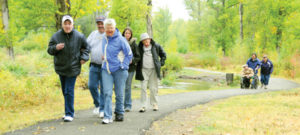Walking Equipment
 Shoes make the Walker: shoes are the single most important piece of equipment for the walker. They can be the difference between having a fun, relaxing walk and an uncomfortable painful walk. It is important to get a good pair of walking shoes with the following characteristics.
Shoes make the Walker: shoes are the single most important piece of equipment for the walker. They can be the difference between having a fun, relaxing walk and an uncomfortable painful walk. It is important to get a good pair of walking shoes with the following characteristics.
- Provide support and comfort to all parts of the foot.
- Have enough toe room that you can wiggle your toes.
- Add firm support at the heel.
- Have flexible cushion so in order to aid in the walking gate and to absorb shock.
- Be made of breathable material, preferably leather, or fabric to allow perspiration to dissipate.
- Be lightweight
Walking Equipment
There are many shoes at various price ranges designed specifically for walking. A running shoe or tennis shoe will also serve for walking so long as it is comfortable and has the above characteristics.
Cool down: after you walk, slow down gradually. Spent five minutes walking slowly. Abruptly stopping your exercise can result in dizziness. Again, these five minutes should not be included in your exercise time.
Keep your heart rate on target: one way of determining how hard you should exercise is by measuring your heart rate. To get a true aerobic benefit of walking, without the risk of over or under training, it is necessary to keep your heart rate within its target zone for a minimum of 15 to 30 minutes. This target zone is between 60% and 85% of your maximum heart rate, the fastest your heart can beat. Below 60%, your walk will have little aerobic benefit, and above 85%, it would be too strenuous. If this is your first walking program, it is advisable that you keep your heart rate within 60 to 75% of the maximum aiming for 60%. Only someone in excellent physical shape should aim for 85%.
How to Measure your pulse: there are a number of methods to to determine your pulse. Place two fingers, (don’t use the thumb since it has its own pulse) on either your wrist or throat or temple. Count the pulse beats for 10 seconds and multiplied by six to get your pulse rate per minute. Use of a pulse meter is another good method to do this. You should periodically check your pulse during your walk, to make sure you are still in the target zone.
For more exercise-related posts, click here.
You can follow any responses to this entry through the RSS 2.0 feed. You can leave a response, or trackback from your own site.


Leave a Reply